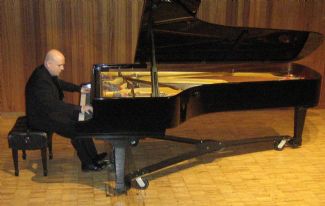|
Symphony
FROM THE NEW WORLD TO THE OLD WORLD
by Peter Lert
Saturday, June 14, 2025
Chamber
MC2 DUO RECITAL CLOSES 222'S SEASON
by Terry McNeill
Saturday, June 14, 2025
Choral and Vocal
CANTIAMO SONOMA'S LUSCIOUS A CAPELLA SINGING IN SEASON ENDING CONCERT
by Pamela Hicks Gailey
Sunday, June 8, 2025
Symphony
SRS SEASON ENDS WITH RESOUNDING TA-TA-TA-BANG
by Terry McNeill
Sunday, June 1, 2025
Symphony
YOUTHFUL VIRTUOSITY ON DISPLAY AT USO'S MAY CONCERTS
by Peter Lert
Saturday, May 17, 2025
Symphony
MYSTICAL PLANETS AND LIVELY GERSHWIN ORTIZ AT FINAL SRS CONCERT
by Peter Lert
Sunday, May 4, 2025
Symphony
VSO'S CONCERT MUSIC OF TIME, MUSIC OF PLACE
by Peter Lert
Sunday, April 27, 2025
VOCAL ELEGANCE AND FIRE AT THE 222'S RECITAL APRIL 26
by Pamela Hicks Gailey
Saturday, April 26, 2025
CANTIAMO SONOMA SINGS AN INSPIRED GOOD FRIDAY MOZART REQUIEM CONCERT
by Pamela Hicks Gailey
Friday, April 18, 2025
DRAMATIC SHOSTAKOVICH SYMPHONY CLOSES PHILHARMONIC'S 25TH SEASON
by Terry McNeill
Sunday, April 13, 2025
|
 |
 Steven Spooner Playing Liszt's 2nd Legend Feb. 27 |
PROGRAM CHANGES TRANSFORM SPOONER'S LISZT IN NEWMAN HALL RECITAL
by Terry McNeill
Sunday, February 27, 2011
Steven Spooner is a pianist of many musical surprises. In his Feb. 27 recital for Concerts Grand in SRJC’s Newman Auditorium, the Kansas University artist sharply changed the printed program, beginning with a work of his own. The unexpected changes made a good recital, on paper, into an exceptional experience.
That work of his own, a meandering “new age” Etude in the fashion of jazz artist Keith Jarrett, worked well to quiet an audience of 90 in the chilly hall. The tune “My Funny Valentine” was imbedded in the chromaticism, and clearly Mr. Spooner understands Mr. Jarrett’s poetic keyboard style.
Three Chopin works, also sans program notes, followed, beginning with the first Polonaise in C Sharp, Op. 26. This lyrical piece has a bold opening that recurs often and the pianist gave each repetition a different character. The same could be said of the playing of the youthful Mazurkas of Op. 7, the bagpipe trio of the Mazurka in F beautifully phrased. Mr. Spooner’s Chopin pianism featured subtle meter shifts and equally subtle colors, both central to an artistic Mazurka reading. His rubatos were many and old fashioned, a la Paderewski.
Finally deciding to play a programmed work, the pianist launched into the not popular but telling Haydn’s 48th Sonata in C, Hob. XIV/35. The two-movement Sonata received the pianist’s close attention to the improvisatory opening’s slowly-unfolding theme, and the closing second movement was effervescent with Haydn’s ubiquitous humor, clear scale playing and a catchy left-hand upward bass run that appeared twice. Wonderful music, expertly played.
The first half ended with the printed program’s ending for the second half, Liszt’s sweeping Second Legend (St. Francis Walking on the Waves), from 1863. This performance was radically different that Elenor Barcsak’s lyrical performance in Marin in 2010 and the Antonio Iturrioz performance in April of 2009 in Newman that was diminished by “luftpause” breaks in the long line. Mr. Spooner had the endurance to push the broken octaves in the left hand to maximum volume and the feeling of rolling waves was palpable. This is program music that demands a bravura technique, the religious ecstasy evident at the end when the pianist created the great saint on his cloak crossing the roaring ocean.
Another fascinating program change occupied the entire second half, Liszt’s B Minor Sonata. Santa Rosa has heard recent performances of this 1853 masterpiece from Hewitt, Bronfman, Margulis and most notably Garrick Ohlsson in 2007, and Mr. Spooner’s interpretation had a little from each, but the whole was entirely his own. His comments to the audience, always to the point and engrossing, cast the formidable 30-minute work as encompassing the composer’s deeply religious nature and thoughts of immortality. Mr. Spooner has a technique that is not naturally facile and I would suspect the glittering fast-speed octaves and orchestral chord playing are the result of long work and thought on the Sonata. The bucolic chorale sections interrupting surging parts of the single movement were a transfiguration, calling a listener’s attention to celestial space and repose. He was never in a hurry to get anywhere and his rhythmic mastery was complete.
At the original end of this extraordinary music odyssey a single fortissimo chord is heard , but Liszt altered the that score to add 32 more measures, gradually having them fading away to pianissimo. Mr. Spooner’s chordal weighting and pedal control was superb, the music sonorous but fleeting, and there was a ten-second hush beyond the final bottom B note (played neither staccato nor as a fermata).
If an encore was demanded, and it was, it had to be something diametrically opposed to the storms of the Legend and Sonata. Mr. Spooner presented Chopin’s “Farewell” Waltz in F Minor, Op. 69, No. 1. It was an understated performance, perfectly capturing the melancholy and nostalgia.
The reviewer is also the producer of the Concerts Grand series.
|

